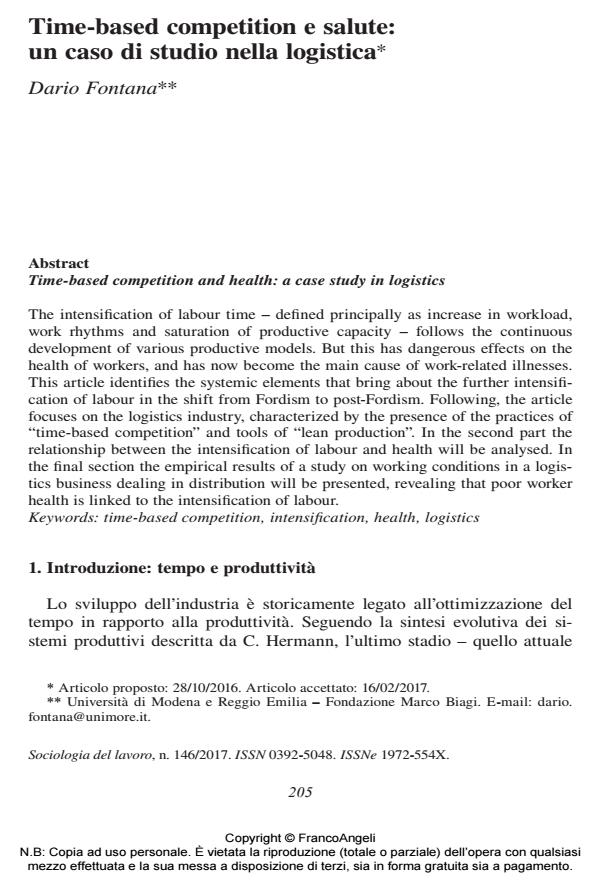Time-based competition and health: a case study in logistics
Journal title SOCIOLOGIA DEL LAVORO
Author/s Dario Fontana
Publishing Year 2017 Issue 2017/146
Language Italian Pages 17 P. 205-221 File size 118 KB
DOI 10.3280/SL2017-146013
DOI is like a bar code for intellectual property: to have more infomation
click here
Below, you can see the article first page
If you want to buy this article in PDF format, you can do it, following the instructions to buy download credits

FrancoAngeli is member of Publishers International Linking Association, Inc (PILA), a not-for-profit association which run the CrossRef service enabling links to and from online scholarly content.
The intensification of labour time - defined principally as increase in workload, work rhythms and saturation of productive capacity - follows the continuous development of various productive models. But this has dangerous effects on the health of workers, and has now become the main cause of work-related illnesses. This article identifies the systemic elements that bring about the further intensification of labour in the shift from Fordism to post-Fordism. Following, the article focuses on the logistics industry, characterized by the presence of the practices of "time-based competition" and tools of "lean production". In the second part the relationship between the intensification of labour and health will be analysed. In the final section the empirical results of a study on working conditions in a logistics business dealing in distribution will be presented, revealing that poor worker health is linked to the intensification of labour.
L’intensificazione del tempo di lavoro - definibile principalmente come au-mento dei carichi, dei ritmi e della saturazione - segue una continua evoluzione lungo i diversi modelli produttivi. Questo fenomeno ha però dei comprovati effetti pericolosi sulla salute dei lavoratori, diventando ormai la causa prevalente delle principali malattie professionali. L’articolo delinea gli elementi di sistema che por-tano ad un ulteriore passaggio di intensificazione del lavoro dal fordismo al post-fordismo. In seguito, l’articolo si concentra sul settore della logistica caratterizzato dalla compresenza delle pratiche di "time-based competition" e degli strumenti della "lean production". Nella seconda parte si analizzano le conseguenze della relazione fra intensificazione e salute. Infine sulla base di una ricerca empirica sulle condizioni di lavoro in un’azienda della logistica di distribuzione - che applica la "lean production" e il "time-based competition" - si sottolinea il critico stato di salute degli operai legato a tempi intensificati.
Keywords: Time-based competition, intensification, health, logistics
- L'organizzazione del lavoro, le condizioni di lavoro e l'intervento sindacale Davide Bubbico, Josua Gräbener, Paula Marcelino, in SOCIOLOGIA DEL LAVORO 151/2018 pp.7
DOI: 10.3280/SL2018-151001 - Agreement between observed and interview-based exposure to ergonomics factors for the upper extremities in employees of a package sorting plant Dario Fontana, Angelo d’Errico, in Ergonomics /2021 pp.512
DOI: 10.1080/00140139.2020.1850881
Dario Fontana, Time-based competition e salute: un caso di studio nella logistica in "SOCIOLOGIA DEL LAVORO " 146/2017, pp 205-221, DOI: 10.3280/SL2017-146013